System Analysis and Design for WPE - ICT284 System Analysis S1 2019
VerifiedAdded on 2023/03/23
|12
|1351
|64
Report
AI Summary
This document presents a comprehensive system analysis and design for the Weddings Parties Everything (WPE) system. It identifies key stakeholders such as customers and caterers, outlining their interests and interactions within the system. The report details functional requirements like registration, login, credit purchase, and request tracking, alongside non-functional requirements such as availability and usability. Use cases are explored using both user goal and event decomposition techniques. A domain model class diagram illustrates the system's entities and their relationships, complemented by a CRUD matrix. The document includes a fully-developed use case description, an activity diagram, a system sequence diagram, and a state machine diagram to visualize system behavior. Finally, a user acceptance test plan is provided to ensure the system meets user expectations. Desklib provides students access to a wide range of solved assignments.
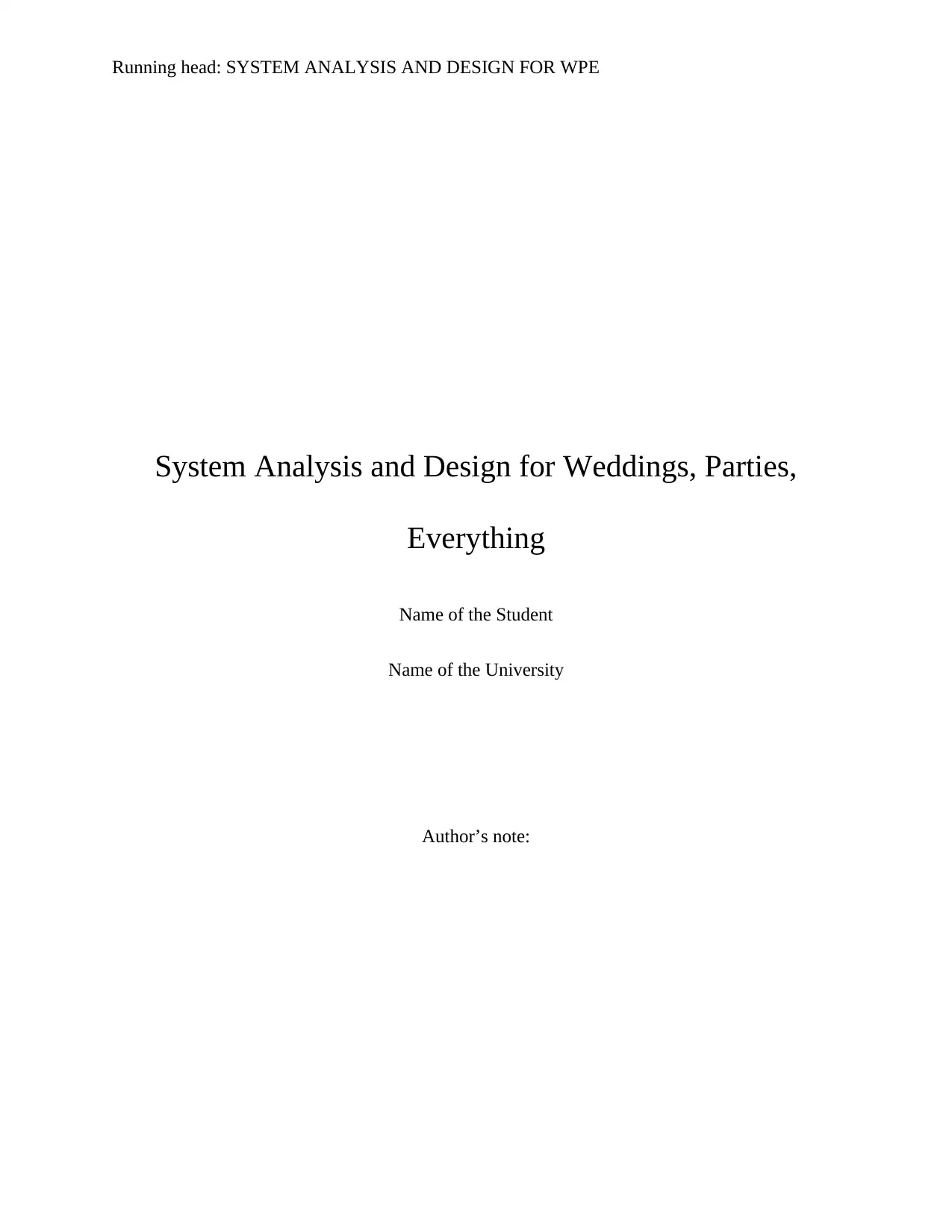
Running head: SYSTEM ANALYSIS AND DESIGN FOR WPE
System Analysis and Design for Weddings, Parties,
Everything
Name of the Student
Name of the University
Author’s note:
System Analysis and Design for Weddings, Parties,
Everything
Name of the Student
Name of the University
Author’s note:
Paraphrase This Document
Need a fresh take? Get an instant paraphrase of this document with our AI Paraphraser

1SYSTEM ANALYSIS AND DESIGN FOR WPE
Table of Contents
Stakeholders:....................................................................................................................................2
Functional and non-functional requirements:..................................................................................2
Functional Requirements:............................................................................................................2
Non-functional requirements:......................................................................................................3
Use Cases:........................................................................................................................................4
User goal technique:....................................................................................................................4
Event decomposition technique:..................................................................................................4
Domain model class diagram...........................................................................................................5
CRUD matrix:..................................................................................................................................5
Fully-developed use case description:.............................................................................................7
Activity diagram:.............................................................................................................................8
System sequence diagram:...............................................................................................................9
State machine diagram:..................................................................................................................10
User acceptance test plan:..............................................................................................................10
Bibliography:.................................................................................................................................11
Table of Contents
Stakeholders:....................................................................................................................................2
Functional and non-functional requirements:..................................................................................2
Functional Requirements:............................................................................................................2
Non-functional requirements:......................................................................................................3
Use Cases:........................................................................................................................................4
User goal technique:....................................................................................................................4
Event decomposition technique:..................................................................................................4
Domain model class diagram...........................................................................................................5
CRUD matrix:..................................................................................................................................5
Fully-developed use case description:.............................................................................................7
Activity diagram:.............................................................................................................................8
System sequence diagram:...............................................................................................................9
State machine diagram:..................................................................................................................10
User acceptance test plan:..............................................................................................................10
Bibliography:.................................................................................................................................11

2SYSTEM ANALYSIS AND DESIGN FOR WPE
Stakeholders:
Customer: The customers are the stakeholders of the system who hire caterers for their
event. The customer is the main income of source for the organization. The customers are
allowed to use the WPE system without paying any charge. The customers can submit their
requests through a form. The form will hold the information like all the things needed to conduct
the catering along with the venue of the event. The customer are allowed to decide any of the
caterer who have responded to customer’s request. The customer has to respond to caterer quote
within forty eight hours or else the request will be deleted from system.
The interest of the customer is getting good quality of service for optimal price. They
want the best caterer suitable for their event within their budget.
Caterer: The interest of the caterer is to find new customers and compete with the other
caterers. The caterers have to pay to use the system. The caterer make the payment to buy
credits. These credits are used to prepare quotes for the customers. The higher the credit, the
higher the quote can be. This means that high credit owner caterers can quote for big events.
Functional and non-functional requirements:
Functional Requirements:
Registration: The caterers can only use the system after they register into the system. The
registration requires the caterer to provide business name, description, types of services they
provide, their location, link to their own website, and contact email. The registration continues
when the caterer is verified. After verification, the caterer provides ABN, business name, logo,
and proof of current Public Liability or Professional Indemnity insurance. The customer can look
for caterers in the system without registration. However, if they want to submit the form, they
Stakeholders:
Customer: The customers are the stakeholders of the system who hire caterers for their
event. The customer is the main income of source for the organization. The customers are
allowed to use the WPE system without paying any charge. The customers can submit their
requests through a form. The form will hold the information like all the things needed to conduct
the catering along with the venue of the event. The customer are allowed to decide any of the
caterer who have responded to customer’s request. The customer has to respond to caterer quote
within forty eight hours or else the request will be deleted from system.
The interest of the customer is getting good quality of service for optimal price. They
want the best caterer suitable for their event within their budget.
Caterer: The interest of the caterer is to find new customers and compete with the other
caterers. The caterers have to pay to use the system. The caterer make the payment to buy
credits. These credits are used to prepare quotes for the customers. The higher the credit, the
higher the quote can be. This means that high credit owner caterers can quote for big events.
Functional and non-functional requirements:
Functional Requirements:
Registration: The caterers can only use the system after they register into the system. The
registration requires the caterer to provide business name, description, types of services they
provide, their location, link to their own website, and contact email. The registration continues
when the caterer is verified. After verification, the caterer provides ABN, business name, logo,
and proof of current Public Liability or Professional Indemnity insurance. The customer can look
for caterers in the system without registration. However, if they want to submit the form, they
⊘ This is a preview!⊘
Do you want full access?
Subscribe today to unlock all pages.

Trusted by 1+ million students worldwide
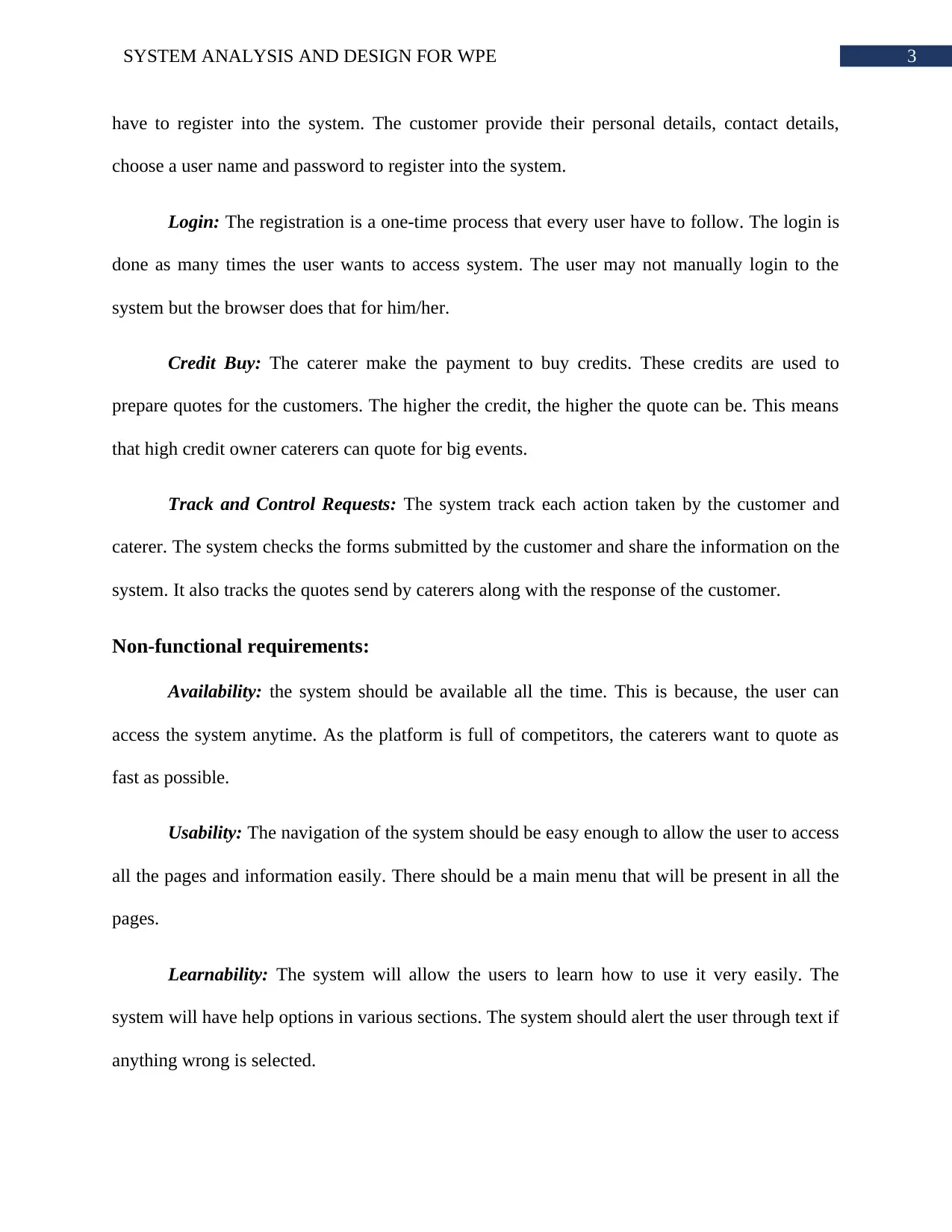
3SYSTEM ANALYSIS AND DESIGN FOR WPE
have to register into the system. The customer provide their personal details, contact details,
choose a user name and password to register into the system.
Login: The registration is a one-time process that every user have to follow. The login is
done as many times the user wants to access system. The user may not manually login to the
system but the browser does that for him/her.
Credit Buy: The caterer make the payment to buy credits. These credits are used to
prepare quotes for the customers. The higher the credit, the higher the quote can be. This means
that high credit owner caterers can quote for big events.
Track and Control Requests: The system track each action taken by the customer and
caterer. The system checks the forms submitted by the customer and share the information on the
system. It also tracks the quotes send by caterers along with the response of the customer.
Non-functional requirements:
Availability: the system should be available all the time. This is because, the user can
access the system anytime. As the platform is full of competitors, the caterers want to quote as
fast as possible.
Usability: The navigation of the system should be easy enough to allow the user to access
all the pages and information easily. There should be a main menu that will be present in all the
pages.
Learnability: The system will allow the users to learn how to use it very easily. The
system will have help options in various sections. The system should alert the user through text if
anything wrong is selected.
have to register into the system. The customer provide their personal details, contact details,
choose a user name and password to register into the system.
Login: The registration is a one-time process that every user have to follow. The login is
done as many times the user wants to access system. The user may not manually login to the
system but the browser does that for him/her.
Credit Buy: The caterer make the payment to buy credits. These credits are used to
prepare quotes for the customers. The higher the credit, the higher the quote can be. This means
that high credit owner caterers can quote for big events.
Track and Control Requests: The system track each action taken by the customer and
caterer. The system checks the forms submitted by the customer and share the information on the
system. It also tracks the quotes send by caterers along with the response of the customer.
Non-functional requirements:
Availability: the system should be available all the time. This is because, the user can
access the system anytime. As the platform is full of competitors, the caterers want to quote as
fast as possible.
Usability: The navigation of the system should be easy enough to allow the user to access
all the pages and information easily. There should be a main menu that will be present in all the
pages.
Learnability: The system will allow the users to learn how to use it very easily. The
system will have help options in various sections. The system should alert the user through text if
anything wrong is selected.
Paraphrase This Document
Need a fresh take? Get an instant paraphrase of this document with our AI Paraphraser
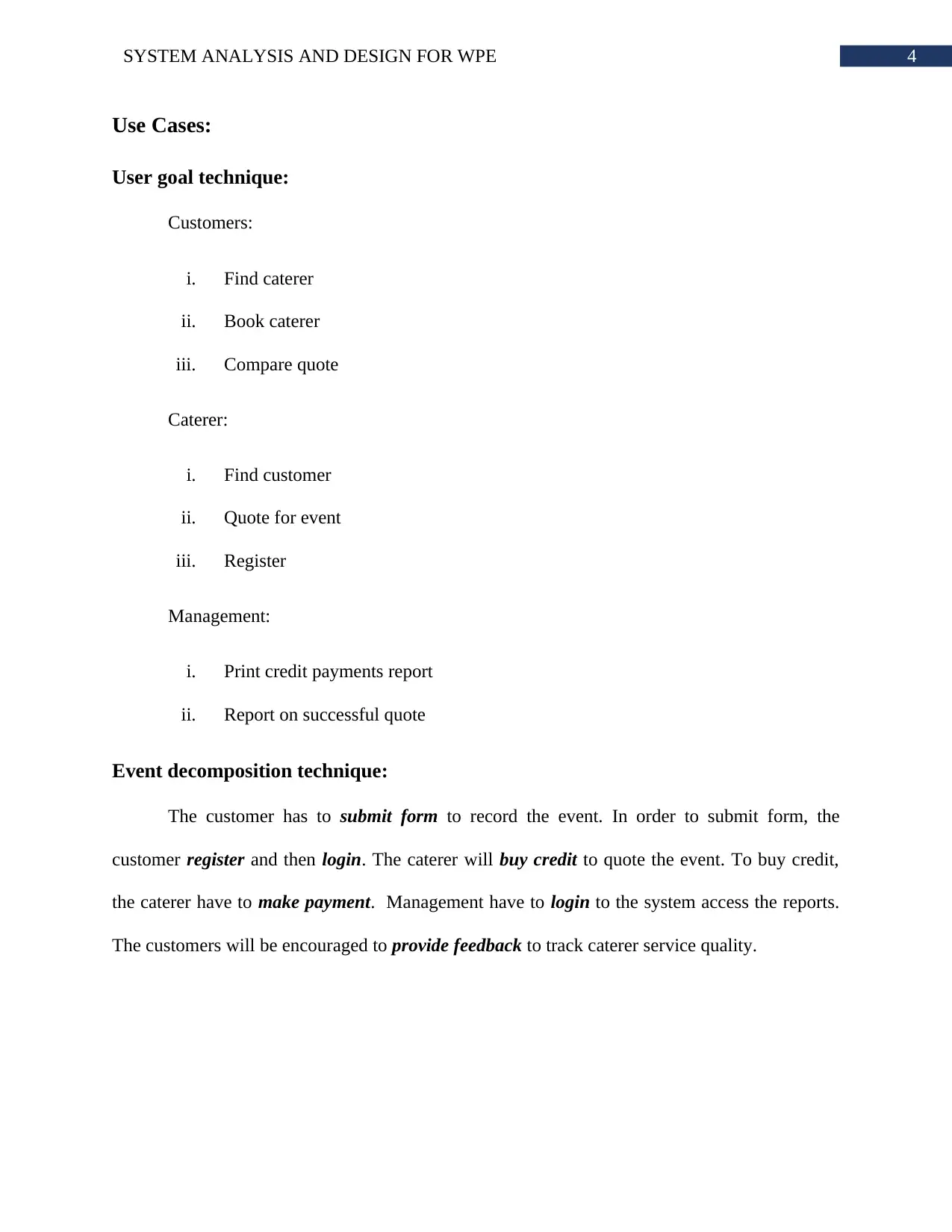
4SYSTEM ANALYSIS AND DESIGN FOR WPE
Use Cases:
User goal technique:
Customers:
i. Find caterer
ii. Book caterer
iii. Compare quote
Caterer:
i. Find customer
ii. Quote for event
iii. Register
Management:
i. Print credit payments report
ii. Report on successful quote
Event decomposition technique:
The customer has to submit form to record the event. In order to submit form, the
customer register and then login. The caterer will buy credit to quote the event. To buy credit,
the caterer have to make payment. Management have to login to the system access the reports.
The customers will be encouraged to provide feedback to track caterer service quality.
Use Cases:
User goal technique:
Customers:
i. Find caterer
ii. Book caterer
iii. Compare quote
Caterer:
i. Find customer
ii. Quote for event
iii. Register
Management:
i. Print credit payments report
ii. Report on successful quote
Event decomposition technique:
The customer has to submit form to record the event. In order to submit form, the
customer register and then login. The caterer will buy credit to quote the event. To buy credit,
the caterer have to make payment. Management have to login to the system access the reports.
The customers will be encouraged to provide feedback to track caterer service quality.
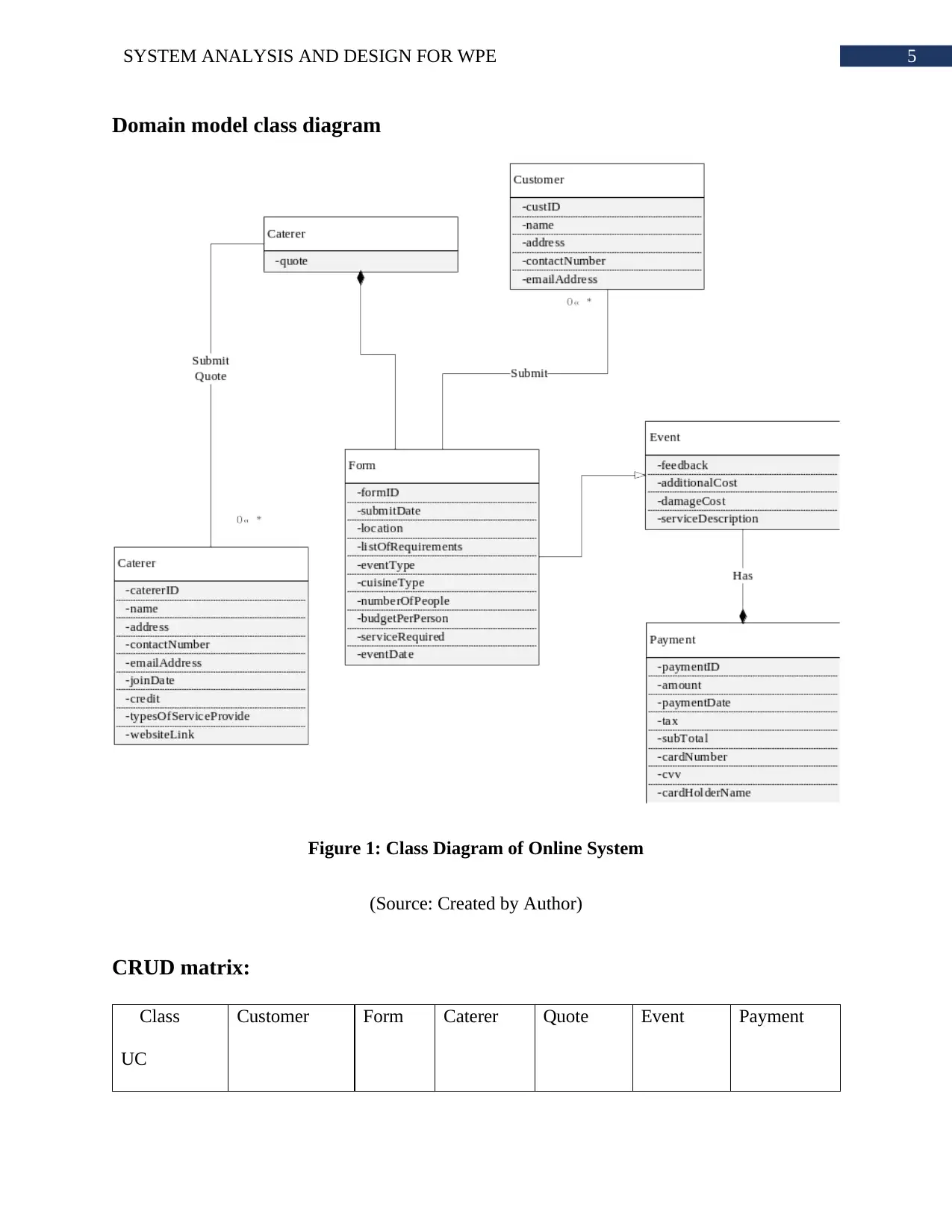
5SYSTEM ANALYSIS AND DESIGN FOR WPE
Domain model class diagram
Figure 1: Class Diagram of Online System
(Source: Created by Author)
CRUD matrix:
Class
UC
Customer Form Caterer Quote Event Payment
Domain model class diagram
Figure 1: Class Diagram of Online System
(Source: Created by Author)
CRUD matrix:
Class
UC
Customer Form Caterer Quote Event Payment
⊘ This is a preview!⊘
Do you want full access?
Subscribe today to unlock all pages.

Trusted by 1+ million students worldwide
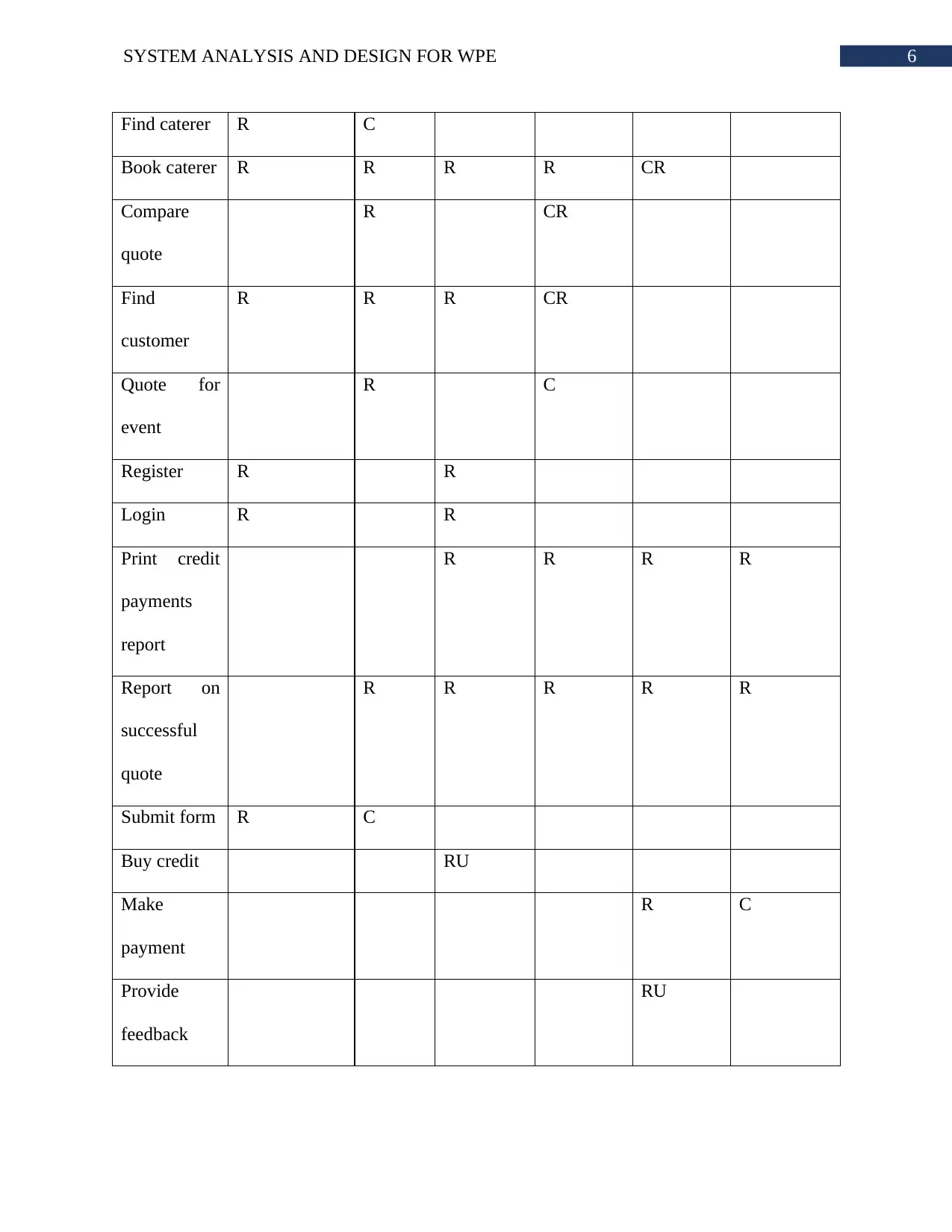
6SYSTEM ANALYSIS AND DESIGN FOR WPE
Find caterer R C
Book caterer R R R R CR
Compare
quote
R CR
Find
customer
R R R CR
Quote for
event
R C
Register R R
Login R R
Print credit
payments
report
R R R R
Report on
successful
quote
R R R R R
Submit form R C
Buy credit RU
Make
payment
R C
Provide
feedback
RU
Find caterer R C
Book caterer R R R R CR
Compare
quote
R CR
Find
customer
R R R CR
Quote for
event
R C
Register R R
Login R R
Print credit
payments
report
R R R R
Report on
successful
quote
R R R R R
Submit form R C
Buy credit RU
Make
payment
R C
Provide
feedback
RU
Paraphrase This Document
Need a fresh take? Get an instant paraphrase of this document with our AI Paraphraser

7SYSTEM ANALYSIS AND DESIGN FOR WPE
Fully-developed use case description:
Use Case Name: Find caterer
Scenario: The customer wants to find a caterer for an event
Triggering Event: Customer wants to book an event
Brief Description: The customer searches for a customer who can provide satisfactory
service within customer budget
Actors: Customer
Stakeholders: Customer, Caterer and Edison
Preconditions: Customer needs to be logged in
Postconditions: Customer has submit a form
Flow of Activities: Actor System
Customer open the system
Customer submit a form
System shows a search bar
The system searches for caterer
suitable to handle the event
Exception Conditions: No caterer is available suitable for event
Fully-developed use case description:
Use Case Name: Find caterer
Scenario: The customer wants to find a caterer for an event
Triggering Event: Customer wants to book an event
Brief Description: The customer searches for a customer who can provide satisfactory
service within customer budget
Actors: Customer
Stakeholders: Customer, Caterer and Edison
Preconditions: Customer needs to be logged in
Postconditions: Customer has submit a form
Flow of Activities: Actor System
Customer open the system
Customer submit a form
System shows a search bar
The system searches for caterer
suitable to handle the event
Exception Conditions: No caterer is available suitable for event

8SYSTEM ANALYSIS AND DESIGN FOR WPE
Activity diagram:
Figure 2: Activity Diagram of Print credit payments report
(Source: Created by Author)
Activity diagram:
Figure 2: Activity Diagram of Print credit payments report
(Source: Created by Author)
⊘ This is a preview!⊘
Do you want full access?
Subscribe today to unlock all pages.

Trusted by 1+ million students worldwide

9SYSTEM ANALYSIS AND DESIGN FOR WPE
System sequence diagram:
Figure 3: Sequence Diagram of Provide feedback
(Source: Created by Author)
System sequence diagram:
Figure 3: Sequence Diagram of Provide feedback
(Source: Created by Author)
Paraphrase This Document
Need a fresh take? Get an instant paraphrase of this document with our AI Paraphraser

10SYSTEM ANALYSIS AND DESIGN FOR WPE
State machine diagram:
Figure 4: State Machine Diagram of Catering Object
(Source: Created by Author)
User acceptance test plan:
Use case name Test Condition Expected Outcome
Submit Form Add Form, Update Form,
Delete old form
New form with every data
Share form details with
caterer
Select Caterer Add Event New event with no Feedback
data, New payment with
empty fields
State machine diagram:
Figure 4: State Machine Diagram of Catering Object
(Source: Created by Author)
User acceptance test plan:
Use case name Test Condition Expected Outcome
Submit Form Add Form, Update Form,
Delete old form
New form with every data
Share form details with
caterer
Select Caterer Add Event New event with no Feedback
data, New payment with
empty fields
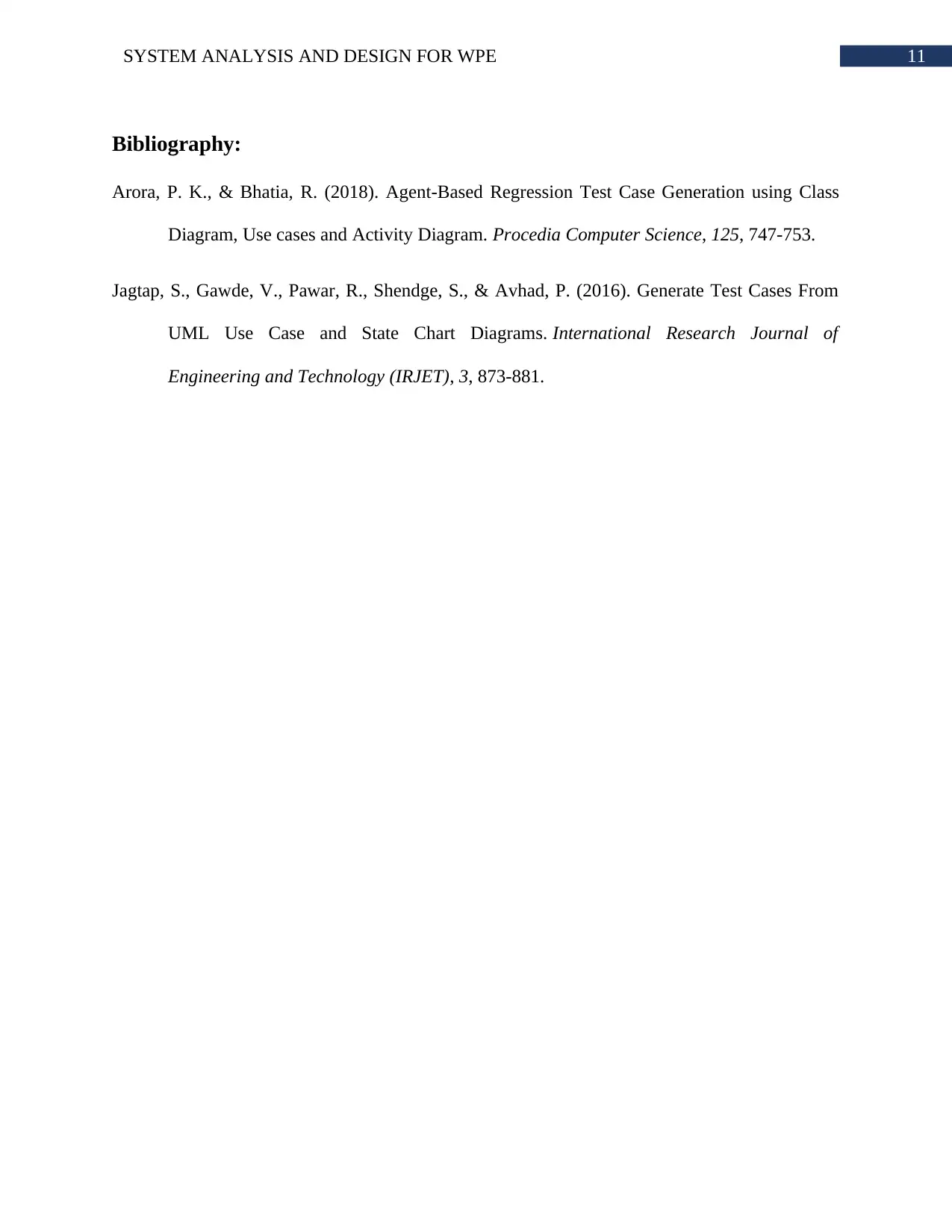
11SYSTEM ANALYSIS AND DESIGN FOR WPE
Bibliography:
Arora, P. K., & Bhatia, R. (2018). Agent-Based Regression Test Case Generation using Class
Diagram, Use cases and Activity Diagram. Procedia Computer Science, 125, 747-753.
Jagtap, S., Gawde, V., Pawar, R., Shendge, S., & Avhad, P. (2016). Generate Test Cases From
UML Use Case and State Chart Diagrams. International Research Journal of
Engineering and Technology (IRJET), 3, 873-881.
Bibliography:
Arora, P. K., & Bhatia, R. (2018). Agent-Based Regression Test Case Generation using Class
Diagram, Use cases and Activity Diagram. Procedia Computer Science, 125, 747-753.
Jagtap, S., Gawde, V., Pawar, R., Shendge, S., & Avhad, P. (2016). Generate Test Cases From
UML Use Case and State Chart Diagrams. International Research Journal of
Engineering and Technology (IRJET), 3, 873-881.
⊘ This is a preview!⊘
Do you want full access?
Subscribe today to unlock all pages.

Trusted by 1+ million students worldwide
1 out of 12
Related Documents
Your All-in-One AI-Powered Toolkit for Academic Success.
+13062052269
info@desklib.com
Available 24*7 on WhatsApp / Email
![[object Object]](/_next/static/media/star-bottom.7253800d.svg)
Unlock your academic potential
Copyright © 2020–2025 A2Z Services. All Rights Reserved. Developed and managed by ZUCOL.





